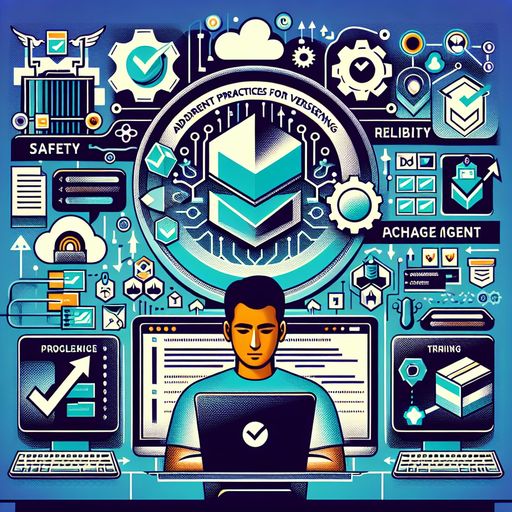I'm Samuel FajreldinesI am a specialist in the entire JavaScript and TypeScript ecosystem (including Node.js, React, Angular and Vue.js) I am expert in AI and in creating AI integrated solutions I am expert in DevOps and Serverless Architecture (AWS, Google Cloud and Azure) I am expert in PHP and its frameworks (such as Codeigniter and Laravel). |
Samuel FajreldinesI am a specialist in the entire JavaScript and TypeScript ecosystem. I am expert in AI and in creating AI integrated solutions. I am expert in DevOps and Serverless Architecture I am expert in PHP and its frameworks.
|
Why You Should Always Specify Version Numbers in Docker and Package Managers

Modern software development has become increasingly process-driven, with automated builds, continuous delivery, and deployments often spanning multiple environments. In this landscape, consistently reproducible builds and deployments aren’t just “nice to have” — they’re essential. However, achieving reproducibility can be surprisingly difficult when the underlying dependencies (from operating system libraries to Node.js packages and beyond) are constantly in flux. This is where rigid version control in Docker images and packages comes into play. Specifying version numbers in Dockerfiles and package managers is one of the most critical strategies to help ensure stability, bolster security, and maintain your project’s long-term scalability.
In what follows, we will explore the reasons behind locking down versions and illustrate how version-pin strategies can be the cornerstone of a stable, maintainable development environment. We’ll also discuss the finer points of Docker image tags, how version constraints function in popular package managers, and offer proven best practices for consistently specifying versions throughout your projects.
Minimizing Surprises in Production
One of the fundamental principles of reliable software production is to avoid surprises. Surprises often come in the form of sudden failures or changes in behavior due to unplanned updates in dependencies. When relying on Docker images tagged simply as “latest,” you risk pulling down new changes that break compatibility or introduce subtle bugs. For instance:
• A new operating system patch may remove or alter a library your application depends on.
• A base image might shift from one Linux distribution version to another.
• Minor version updates in language runtimes could introduce deprecation warnings or break existing code that relies on previously stable behavior.
The same principle applies to package managers such as npm, Yarn, or Pip. Without explicit version pinning, you’re at the mercy of the software’s latest release, which could unexpectedly alter functionalities or break your application due to changes in dependencies. By specifying the exact version in the Dockerfile (for example, FROM node:14.17.3 instead of FROM node:14 or FROM node:latest) and package.json (for instance, "react": "17.0.2" instead of "^17.0.2"), you ensure that you know exactly what is being built and deployed.
Ensuring Build Reproducibility and Dependency Hygiene
Build reproducibility is critical. Without it, debugging becomes complicated — developers attempting to replicate a production bug may never be able to fully reproduce the environment. When version updates occur unexpectedly, the same code can suddenly behave differently. This lack of reproducibility can make triaging issues significantly more time-consuming and hamper overall productivity.
Explicitly specifying versions in the Docker image:
# Avoid using generic tags like 'latest'
FROM node:14.17.3And in your Node.js projects, for example:
{
"dependencies": {
"express": "4.17.3",
"mongoose": "5.13.5"
}
}By deliberately pinning versions, you create a shared reference point that every developer on the project can rely on. The entire development team will always be running the same foundational environment — from local machines to staging and production servers. This “dependency hygiene” not only contributes to faster debugging but also helps ensure that new developers onboarded to your team know the environment they’ll be working with is stable and consistent, no matter how many library updates have been released since you began the project.
Security Considerations and Patches
Security is a constant concern in software development. Vulnerabilities can appear in runtime environments, system libraries, or in third-party packages. When you lock to a specific version, you have complete visibility into what you’re using, making it easier to track security advisories and apply patches where needed.
With Docker, each base image is periodically updated. If you always use the “latest” tag, you may find yourself in one of two scenarios:
- You might miss critical security patches that are only present in newer releases (if your base image hasn't been rebuilt recently).
- You could encounter a break in functionality because the “latest” version might include changes or updates that are incompatible with your code.
By choosing a specific version (e.g., FROM ubuntu:20.04 instead of FROM ubuntu:latest), you’ll know exactly which patches are currently present in your container. You can then keep track of known vulnerabilities and make an informed decision to upgrade or patch when it’s convenient for your release cycle. The same logic applies to dependencies within your Node.js, Python, Java, or PHP applications: the package manager logs the exact version, and you’ll be able to respond promptly to security patches by upgrading or substituting only those dependencies that need patches.
Preventing Dependency Drift and “Dependency Hell”
In the world of package management, the dreaded “dependency hell” often occurs when multiple libraries and packages have conflicting version requirements or rely on sub-dependencies that become incompatible over time. By specifying version numbers meticulously, you minimize transformation in your dependency graph over each deployment or build cycle, preventing your application from gradually drifting towards an unmaintainable state.
For instance, if a package A depends on version 2.0 of package B, but package C depends on version 3.0 of package B, letting your dependencies float to the latest release can lead to conflicts. Sticking to specific versions ensures that you can systematically address these conflicts before merging new changes or deploying code, rather than discovering them when your app breaks in production.
Docker Tagging Strategies: Immutable Tags vs. Semantic Versioning
Docker images can be tagged in a variety of ways. The simplest approach is to use a “latest” tag, but as we’ve discussed, that can be dangerous. Instead, consider the following strategies:
-
Semantic Version Tags
Images can be tagged with versions that follow a clear pattern, such as 2.0, 2.0.1, etc. When updating your project, you can move from 2.0 to 2.0.1 in a single step, verifying the changes. This approach provides more control and ensures you know exactly which build is running. -
Immute Tagging (SHA Digests)
Docker allows referencing images by a unique SHA digest. This guarantees that the image pulled is precisely the one you expect, as no two images share the same SHA. Referencing images by digest is arguably one of the most robust ways to ensure reproducibility, although it can be less human-readable than semantic version tags. -
Rolling Tags
Some organizations create “rolling tags” for specific environments, like staging or production. While this can streamline certain operational processes, it’s still crucial to know which exact version or commit is associated with each tag behind the scenes.
Regardless of the strategy, the goal is to ensure that once you set an image reference, you know immediately what that environment looks like and can roll back, if needed, to a stable version. Tying Docker tags in your deployment pipelines with version control or continuous integration ensures that your entire infrastructure is traceable and reproducible.
Package Versioning in Node, PHP, and Beyond
While Docker manages the base environment, frameworks and libraries are managed by package managers. Whether you use npm, Yarn, Composer, or pip, each has a unique syntax for specifying version ranges:
• Exact versions (e.g., "mongoose": "5.10.3"): The gold standard for locking dependencies.
• Caret ranges (e.g., "mongoose": "^5.10.3"): Allows patch and minor updates but can introduce surprises.
• Tilde ranges (e.g., "mongoose": "~5.10.3"): Allows only patch-level updates.
• Wildcards (e.g., "mongoose": "*"): Highly discouraged in production environments.
Exact version pinning is typically the safest route for mission-critical software. It eliminates guesswork about the effects of minor or patch updates. However, some teams opt for a compromise — such as using tilde (~) ranges to get necessary security patches but avoid major version jumps that could break compatibility. The key to success is implementing a robust regression testing pipeline so that if a minor or patch version does introduce a breaking change, you catch it early in staging or testing environments.
Automated CI/CD Pipelines for Version Management
A major factor in the DevOps landscape is the use of continuous integration and continuous delivery (CI/CD) pipelines, which can automate testing, security checks, and deployments. When version numbers are explicitly stated:
- CI servers know exactly which versions of packages or images to install, ensuring the build process is stable.
- Staging environments match production precisely, making the transition from test to production less risky.
- Rollbacks become easier. If something goes wrong with version 2.1.0 of a dependency or Docker image, you can swiftly revert to version 2.0.0 without guesswork.
By integrating version checks into pipelines (e.g., verifying that Docker images match a known hash or that package.json references are locked), teams are forced to maintain discipline. This discipline is the bedrock of stable and predictable releases. Automated tests become even more powerful when you know that changes in test outcomes reflect actual code modifications, not the happenstance of new dependencies sneaking in.
Maintaining Scalability and Team Collaboration
Projects often start small but can expand rapidly. As the codebase and the team grow, so do the number of dependencies and Docker layers. Continuous collaboration on a large team also heightens the chance that someone updates a Dockerfile or package manager references without communicating.
Pinning versions and adopting a documented version strategy help keep everyone on the same page. Through well-maintained Dockerfiles, package.json or composer.json, and lock files (like package-lock.json or composer.lock), you avoid merging changes that could blindside other team members. This is especially true in distributed teams where developers operate across different time zones or use different operating systems. A consistent approach to versioning fosters a cohesive, scalable development environment, reducing overhead in code reviews, QA cycles, and debugging sessions.
Using Version Management as a Teaching Tool
Knowledge sharing is a powerful asset for any organization or open-source community. When new members join the team, they quickly learn the importance of specifying Docker and package versions, simply by examining your repository structure. By maintaining clear, explicit references, your project becomes inherently better documented. Developers can trace the lineage of each dependency, discovering why a particular version is chosen and learning safe upgrade paths.
In large enterprises, these best practices often involve setting up “golden images” for Docker, which are company-approved images pinned to a known good state. Similarly, in package management, organizations may maintain internal registries or mirrors with curated versions of libraries. This level of control ensures that out-of-policy updates do not slip through, and that every environment is verifiably consistent.
Conclusion
Specifying version numbers in Docker and package managers is more than just a detail in your project documentation. It is an essential pillar of modern software engineering, enabling reproducibility, security, collaboration, and long-term scalability. Whether you’re crafting a small side project or an enterprise-grade application deployed across multiple clouds, locking down your Docker images and third-party libraries protects your code from unpredictable upstream changes and provides the transparency to address security issues as they emerge.
When your infrastructure, libraries, and frameworks are pinned to explicit versions, you eliminate guesswork, reduce fragmentation in development environments, and maintain a predictable release cadence. The payoff is a less erratic, more robust, and ultimately more enjoyable development experience. With this clear strategy for version management, projects can flourish, teams can scale with confidence, and your software can reliably deliver the functionality it promises to users, day in and day out.
About Me
Samuel Fajreldines
|
Since I was a child, I've always wanted to be an inventor. As I grew up, I specialized in information systems, an area which I fell in love with and live around it. I am a full-stack developer and work a lot with devops, i.e., I'm a kind of "jack-of-all-trades" in IT. Wherever there is something cool or new, you'll find me exploring and learning... I am passionate about life, family, and sports. I believe that true happiness can only be achieved by balancing these pillars. I am always looking for new challenges and learning opportunities, and would love to connect with other technology professionals to explore possibilities for collaboration. If you are looking for a dedicated and committed full-stack developer with a passion for excellence, please feel free to contact me. It would be a pleasure to talk with you! |
Resume
Experience
-
SecurityScoreCard
Nov. 2023 - Present
New York, United States
Senior Software Engineer
I joined SecurityScorecard, a leading organization with over 400 employees, as a Senior Full Stack Software Engineer. My role spans across developing new systems, maintaining and refactoring legacy solutions, and ensuring they meet the company's high standards of performance, scalability, and reliability.
I work across the entire stack, contributing to both frontend and backend development while also collaborating directly on infrastructure-related tasks, leveraging cloud computing technologies to optimize and scale our systems. This broad scope of responsibilities allows me to ensure seamless integration between user-facing applications and underlying systems architecture.
Additionally, I collaborate closely with diverse teams across the organization, aligning technical implementation with strategic business objectives. Through my work, I aim to deliver innovative and robust solutions that enhance SecurityScorecard's offerings and support its mission to provide world-class cybersecurity insights.
Technologies Used:
Node.js Terraform React Typescript AWS Playwright and Cypress


